Introduction
The internet has changed the world in incredible ways. First, we had Web1 (static websites), then Web2 (social media, apps, and interaction). Now, in 2025, the next revolution is here: Web3. But what exactly is Web3, and why is it so important for the future of the internet? Let’s break it down in simple terms.
1. Web1 → Web2 → Web3: A Quick History
- Web1 (1990s–early 2000s): Read-only internet. Websites gave information, but users couldn’t interact much.
- Web2 (2005–present): Social media, YouTube, e-commerce. Users create content but big companies (Google, Facebook, Amazon) control the data.
- Web3 (now): A decentralized internet where you own your data, identity, and assets.

2. The Key Features of Web3
- Decentralization: Data isn’t controlled by big companies but stored on blockchains.
- User Ownership: You own your digital assets (like NFTs, tokens, or digital IDs).
- Smart Contracts: Automated programs that run without needing banks or middlemen.
- Interoperability: Apps can work together across different blockchains.
3. Examples of Web3 in Action
- Decentralized Finance (DeFi): Banking without banks — lending, borrowing, trading on the blockchain.
- NFTs: Beyond art, NFTs are used for tickets, real estate, music, and identity.
- Decentralized Apps (dApps): Apps that run on blockchain, giving users control.
- Metaverse: Virtual worlds powered by blockchain where users own land, assets, and avatars.

4. Why Web3 Matters
- More Privacy: You decide who gets your data.
- More Freedom: No single company can block you.
- New Opportunities: From earning money in games to creating decentralized businesses.

5. Challenges of Web3
- Complex for beginners (wallets, seed phrases).
- Scams and hacks are common.
- Scalability issues (some blockchains are still slow or expensive).
But just like the early days of the internet, Web3 is improving fast.
Conclusion
Web3 is the next generation of the internet, giving power back to the users. With decentralization, ownership, and innovation, it’s reshaping how we interact online. In 2025 and beyond, Web3 is not just a trend — it’s the future of the digital world.